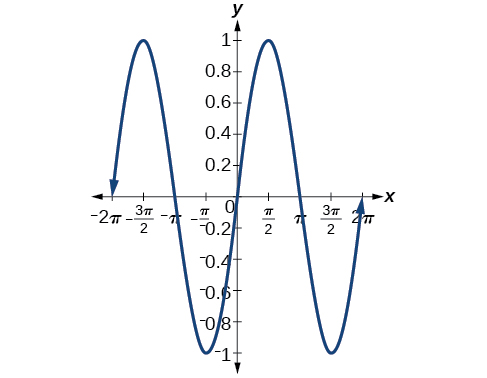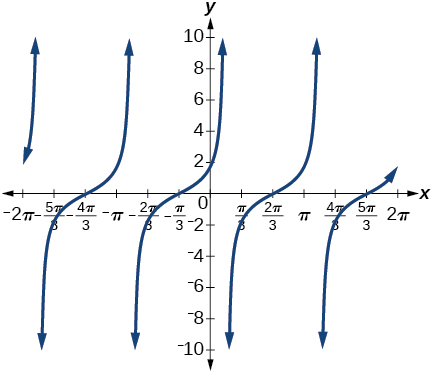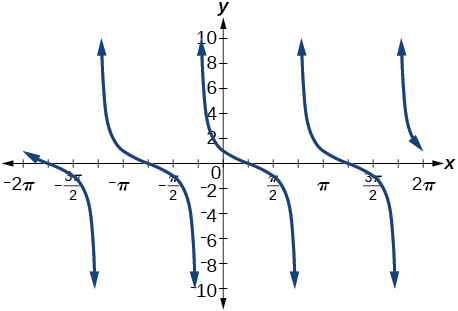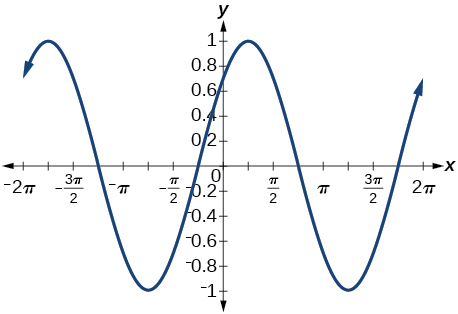1.7.E: Trigonometric Identities and Equations (Exercises)
- Page ID
- 62971
( \newcommand{\kernel}{\mathrm{null}\,}\)
7.1: Solving Trigonometric Equations with Identities
In this section, we will begin an examination of the fundamental trigonometric identities, including how we can verify them and how we can use them to simplify trigonometric expressions.
Verbal
1) We know
- Answer
-
All three functions,
, This is because
2) Examine the graph of
3) After examining the reciprocal identity for
- Answer
-
When
, ,
4) All of the Pythagorean identities are related. Describe how to manipulate the equations to get from
Algebraic
For the exercises 5-15, use the fundamental identities to fully simplify the expression.
5)
- Answer
-
6)
7)
- Answer
-
8)
9)
- Answer
-
10)
11)
- Answer
-
12)
13)
- Answer
-
14)
15)
- Answer
-
For the exercises 16-28, simplify the first trigonometric expression by writing the simplified form in terms of the second expression.
16)
17)
- Answer
-
18)
19)
- Answer
-
20)
21)
- Answer
-
22)
23)
- Answer
-
24)
25)
- Answer
-
26)
27)
- Answer
-
28)
For the exercises 29-33, verify the identity.
29)
- Answer
-
Answers will vary. Sample proof:
30)
31)
- Answer
-
Answers will vary. Sample proof:
32)
33)
- Answer
-
Answers will vary. Sample proof:
Extensions
For the exercises 34-39, prove or disprove the identity.
34)
35)
- Answer
-
False
36)
37)
- Answer
-
False
38)
39)
- Answer
-
Proved with negative and Pythagorean identities
For the exercises 40-, determine whether the identity is true or false. If false, find an appropriate equivalent expression.
40)
41)
- Answer
-
True
42)
7.2: Sum and Difference Identities
In this section, we will learn techniques that will enable us to solve useful problems. The formulas that follow will simplify many trigonometric expressions and equations. Keep in mind that, throughout this section, the term formula is used synonymously with the word identity.
Verbal
1) Explain the basis for the cofunction identities and when they apply.
- Answer
-
The cofunction identities apply to complementary angles. Viewing the two acute angles of a right triangle, if one of those angles measures
, . .
2) Is there only one way to evaluate
3) Explain to someone who has forgotten the even-odd properties of sinusoidal functions how the addition and subtraction formulas can determine this characteristic for
- Answer
-
Algebraic
For the exercises 4-9, find the exact value.
4)
5)
- Answer
-
6)
7)
- Answer
-
8)
9)
- Answer
-
For the exercises 10-13, rewrite in terms of
10)
11)
- Answer
-
12)
13)
- Answer
-
For the exercises 14-19, simplify the given expression.
14)
15)
- Answer
-
16)
17)
- Answer
-
18)
19)
- Answer
-
For the exercises 20-21, find the requested information.
20) Given that
21) Given that
- Answer
-
For the exercises 22-24, find the exact value of each expression.
22)
23)
- Answer
-
24)
Graphical
For the exercises 25-32, simplify the expression, and then graph both expressions as functions to verify the graphs are identical.
25)
- Answer
-

26)
27)
- Answer
-

28)
29)
- Answer
-

30)
31)
- Answer
-

32)
For the exercises 33-41, use a graph to determine whether the functions are the same or different. If they are the same, show why. If they are different, replace the second function with one that is identical to the first. (Hint: think
33)
- Answer
-
They are the same.
34)
35)
- Answer
-
They are different, try
36)
37)
- Answer
-
They are the same.
38)
39)
- Answer
-
They are different, try
40)
41)
- Answer
-
They are different, try
Technology
For the exercises 42-46, find the exact value algebraically, and then confirm the answer with a calculator to the fourth decimal point.
42)
43)
- Answer
-
44)
45)
- Answer
-
46)
Extensions
For the exercises 47-51, prove the identities provided.
47)
- Answer
-
48)
49)
- Answer
-
50)
51)
- Answer
-
For the exercises 52-, prove or disprove the statements.
52)
53)
- Answer
-
True
54)
55) If
- Answer
-
True. Note that
56) If
7.3: Double-Angle, Half-Angle, and Reduction Formulas
In this section, we will investigate three additional categories of identities. Double-angle identities are derived from the sum formulas of the fundamental trigonometric functions: sine, cosine, and tangent. Reduction formulas are especially useful in calculus, as they allow us to reduce the power of the trigonometric term. Half-angle formulas allow us to find the value of trigonometric functions involving half-angles, whether the original angle is known or not.
Verbal
1) Explain how to determine the reduction identities from the double-angle identity
- Answer
-
Use the Pythagorean identities and isolate the squared term.
2) Explain how to determine the double-angle formula for
3) We can determine the half-angle formula for
- Answer
-
4) For the half-angle formula given in the previous exercise for
Algebraic
For the exercises 5-8, find the exact values of a)
5) If
- Answer
-
6) If
7) If
- Answer
-
8) If
For the exercises 9-10, find the values of the six trigonometric functions if the conditions provided hold.
9)
- Answer
-
10)
For the exercises 11-12, simplify to one trigonometric expression.
11)
- Answer
-
12)
For the exercises 13-19, find the exact value using half-angle formulas.
13)
- Answer
-
14)
15)
- Answer
-
16)
17)
- Answer
-
18)
19)
- Answer
-
For the exercises 20-23, find the exact values of a)
20) If
21) If
- Answer
-
22) If
23) If
- Answer
-
For the exercises 24-27, use Figure below to find the requested half and double angles.

24) Find
25) Find
- Answer
-
26) Find
27) Find
- Answer
-
For the exercises 28-33, simplify each expression. Do not evaluate.
28)
29)
- Answer
-
30)
31)
- Answer
-
32)
33)
- Answer
-
For the exercises 34-37, prove the identity given.
34)
35)
- Answer
-
36)
37)
- Answer
-
For the exercises 38-44, rewrite the expression with an exponent no higher than 1.
38)
39)
- Answer
-
40)
41)
- Answer
-
42)
43)
- Answer
-
44)
Technology
For the exercises 45-52, reduce the equations to powers of one, and then check the answer graphically.
45)
- Answer
-
46)
47)
- Answer
-
48)
49)
- Answer
-
50)
51)
- Answer
-
52)
For the exercises 53-54, algebraically find an equivalent function, only in terms of
53)
- Answer
-
54)
Extensions
For the exercises 55-63, prove the identities.
55)
- Answer
-
56)
57)
- Answer
-
58)
59)
- Answer
-
60)
61)
- Answer
-
62)
63)
- Answer
-
7.4: Sum-to-Product and Product-to-Sum Formulas
From the sum and difference identities, we can derive the product-to-sum formulas and the sum-to-product formulas for sine and cosine. The product-to-sum formulas can rewrite products of sines, products of cosines, and products of sine and cosine as sums or differences of sines and cosines. We can also derive the sum-to-product identities from the product-to-sum identities using substitution. The sum-to-product formulas are used to rewrite sum or difference as products of sines and cosines.
Verbal
1) Starting with the product to sum formula
- Answer
-
Substitute
2) Explain two different methods of calculating
3) Explain a situation where we would convert an equation from a sum to a product and give an example.
- Answer
-
Answers will vary. There are some equations that involve a sum of two trig expressions where when converted to a product are easier to solve. For example:
.
4) Explain a situation where we would convert an equation from a product to a sum, and give an example.
Algebraic
For the exercises 5-10, rewrite the product as a sum or difference.
5)
- Answer
-
6)
7)
- Answer
-
8)
9)
- Answer
-
10)
For the exercises 11-16, rewrite the sum or difference as a product.
11)
- Answer
-
12)
13)
- Answer
-
14)
15)
- Answer
-
16)
For the exercises 17-21, evaluate the product for the following using a sum or difference of two functions.
17)
- Answer
-
18)
19)
- Answer
-
20)
21)
- Answer
-
For the exercises 22-26, evaluate the product using a sum or difference of two functions. Leave in terms of sine and cosine.
22)
23)
- Answer
-
24)
25)
- Answer
-
26)
For the exercises 27-31, rewrite the sum as a product of two functions. Leave in terms of sine and cosine.
27)
- Answer
-
28)
29)
- Answer
-
30)
31)
- Answer
-
For the exercises 32-38, prove the identity.
32)
33)
- Answer
-
34)
35)
- Answer
-
36)
37)
- Answer
-
38)
Numeric
For the exercises 39-43, rewrite the sum as a product of two functions or the product as a sum of two functions. Give your answer in terms of sines and cosines. Then evaluate the final answer numerically, rounded to four decimal places.
39)
- Answer
-
40)
41)
- Answer
-
42)
43)
- Answer
-
Technology
For the exercises 44-48, algebraically determine whether each of the given expressions is a true identity. If it is not an identity, replace the right-hand side with an expression equivalent to the left side. Verify the results by graphing both expressions on a calculator.
44)
45)
- Answer
-
It is an identity.
46)
47)
- Answer
-
It is not an identity, but
48)
For the exercises 49-53, simplify the expression to one term, then graph the original function and your simplified version to verify they are identical.
49)
- Answer
-
50)
51)
- Answer
-
52)
53)
- Answer
-
Extensions
For the exercises 54-55, prove the following sum-to-product formulas.
54)
55)
- Answer
-
Start with
. , Since
,
For the exercises 56-63, prove the identity.
56)
57)
- Answer
-
58)
59)
- Answer
-
60)
61)
- Answer
-
62)
63)
- Answer
-
7.5: Solving Trigonometric Equations
In earlier sections of this chapter, we looked at trigonometric identities. Identities are true for all values in the domain of the variable. In this section, we begin our study of trigonometric equations to study real-world scenarios such as the finding the dimensions of the pyramids.
Verbal
1) Will there always be solutions to trigonometric function equations? If not, describe an equation that would not have a solution. Explain why or why not.
- Answer
-
There will not always be solutions to trigonometric function equations. For a basic example,
2) When solving a trigonometric equation involving more than one trig function, do we always want to try to rewrite the equation so it is expressed in terms of one trigonometric function? Why or why not?
3) When solving linear trig equations in terms of only sine or cosine, how do we know whether there will be solutions?
- Answer
-
If the sine or cosine function has a coefficient of one, isolate the term on one side of the equals sign. If the number it is set equal to has an absolute value less than or equal to one, the equation has solutions, otherwise it does not. If the sine or cosine does not have a coefficient equal to one, still isolate the term but then divide both sides of the equation by the leading coefficient. Then, if the number it is set equal to has an absolute value greater than one, the equation has no solution.
Algebraic
For the exercises 4-12, find all solutions exactly on the interval
4)
5)
- Answer
-
6)
7)
- Answer
-
8)
9)
- Answer
-
10)
11)
- Answer
-
12)
For the exercises 13-22, solve exactly on
13)
- Answer
-
14)
15)
- Answer
-
16)
17)
- Answer
-
18)
19)
- Answer
-
20)
21)
- Answer
-
22)
For the exercises 23-32, find all exact solutions on
23)
- Answer
-
24)
25)
- Answer
-
26)
27)
- Answer
-
28)
29)
- Answer
-
30)
31)
- Answer
-
32)
For the exercises 33-40, solve with the methods shown in this section exactly on the interval
33)
- Answer
-
34)
35)
- Answer
-
36)
37)
- Answer
-
38)
39)
- Answer
-
40)
For the exercises 41-49, solve exactly on the interval
41)
- Answer
-
42)
43)
- Answer
-
There are no solutions.
44)
45)
- Answer
-
46)
47)
- Answer
-
48)
49)
- Answer
-
There are no solutions.
For the exercises 50-65, find exact solutions on the interval
50)
51)
- Answer
-
There are no solutions.
52)
53)
- Answer
-
54)
55)
- Answer
-
56)
57)
- Answer
-
58)
59)
- Answer
-
60)
61)
- Answer
-
62)
63)
- Answer
-
64)
65)
- Answer
-
Graphical
For the exercises 66-72, algebraically determine all solutions of the trigonometric equation exactly, then verify the results by graphing the equation and finding the zeros.
66)
67)
- Answer
-
68)
69)
- Answer
-
There are no solutions.
70)
71)
- Answer
-
72)
Technology
For the exercises 73-76, use a calculator to find all solutions to four decimal places.
73)
- Answer
-
74)
75)
- Answer
-
76)
77)
- Answer
-
78)
79)
- Answer
-
80)
81)
- Answer
-
82)
Extensions
For the exercises 83-92, find all solutions exactly to the equations on the interval
83)
- Answer
-
84)
85)
- Answer
-
86)
87)
- Answer
-
There are no solutions.
88)
89)
- Answer
-
90)
91)
- Answer
-
There are no solutions.
92)
Real-World Applications
93) An airplane has only enough gas to fly to a city
- Answer
-
94) If a loading ramp is placed next to a truck, at a height of
95) If a loading ramp is placed next to a truck, at a height of
- Answer
-
96) A woman is watching a launched rocket currently
97) An astronaut is in a launched rocket currently
- Answer
-
98) A woman is standing
99) A man is standing
- Answer
-
100) A
101) A
- Answer
-
102) A spotlight on the ground
103) A spotlight on the ground
- Answer
-
For the exercises 104-106, find a solution to the word problem algebraically. Then use a calculator to verify the result. Round the answer to the nearest tenth of a degree.
104) A person does a handstand with his feet touching a wall and his hands
105) A person does a handstand with her feet touching a wall and her hands
- Answer
-
106) A
7.6: Modeling with Trigonometric Equations
Many natural phenomena are also periodic. For example, the phases of the moon have a period of approximately
Verbal
1) Explain what types of physical phenomena are best modeled by sinusoidal functions. What are the characteristics necessary?
- Answer
-
Physical behavior should be periodic, or cyclical.
2) What information is necessary to construct a trigonometric model of daily temperature? Give examples of two different sets of information that would enable modeling with an equation.
3) If we want to model cumulative rainfall over the course of a year, would a sinusoidal function be a good model? Why or why not?
- Answer
-
Since cumulative rainfall is always increasing, a sinusoidal function would not be ideal here.
4) Explain the effect of a damping factor on the graphs of harmonic motion functions.
Algebraic
For the exercises 5-13, find a possible formula for the trigonometric function represented by the given table of values.
5)
- Answer
-
6)
7)
- Answer
-
8)
9)
- Answer
-
10)
11)
- Answer
-
12)
13)
- Answer
-
Graphical
For the exercises 14-16, graph the given function, and then find a possible physical process that the equation could model.
14)
15)
- Answer
-
![Graph of f(x) = -18cos(x*pi/12) - 5sin(x*pi/12) + 100 on the interval [0,24]. There is a single peak around 12.](https://math.libretexts.org/@api/deki/files/7325/CNX_Precalc_Figure_07_06_202.jpg?revision=1)
Answers will vary. Sample answer: This function could model temperature changes over the course of one very hot day in Phoenix, Arizona.
16)
Technology
For the exercise 17, construct a function modeling behavior and use a calculator to find desired results.
17) A city’s average yearly rainfall is currently
- Answer
-
Real-World Applications
For the exercises 18-29, construct a sinusoidal function with the provided information, and then solve the equation for the requested values.
18) Outside temperatures over the course of a day can be modeled as a sinusoidal function. Suppose the high temperature of
19) Outside temperatures over the course of a day can be modeled as a sinusoidal function. Suppose the high temperature of
- Answer
-
20) Outside temperatures over the course of a day can be modeled as a sinusoidal function. Suppose the temperature varies between
21) Outside temperatures over the course of a day can be modeled as a sinusoidal function. Suppose the temperature varies between
- Answer
-
22) A Ferris wheel is
23)A Ferris wheel is
- Answer
-
24) The sea ice area around the North Pole fluctuates between about
25) The sea ice area around the South Pole fluctuates between about
- Answer
-
From July 8 to October 23
26) During a
27) During a
- Answer
-
From day
28) In a certain region, monthly precipitation peaks at
29) In a certain region, monthly precipitation peaks at
- Answer
-
Floods: July 24 through October 7. Droughts: February 4 through March 27
For the exercises 30-32, find the amplitude, period, and frequency of the given function.
30) The displacement
31) The displacement
- Answer
-
Amplitude:
32) The displacement
For the exercise 33, construct an equation that models the described behavior.
33) The displacement
- Answer
-
Amplitude:
For the exercises 34-41, construct an equation that models the described behavior.
34) A deer population oscillates
35) A rabbit population oscillates
- Answer
-
36) A muskrat population oscillates
37) A fish population oscillates
- Answer
-
38) A spring attached to the ceiling is pulled
39) A spring attached to the ceiling is pulled
- Answer
-
40) A spring attached to the ceiling is pulled
41) A spring attached to the ceiling is pulled
- Answer
-
For the exercises 42-47, create a function modeling the described behavior. Then, calculate the desired result using a calculator.
42) A certain lake currently has an average trout population of
43) Whitefish populations are currently at
- Answer
-
44) A spring attached to a ceiling is pulled down
45) A spring attached to a ceiling is pulled down
- Answer
-
46) Two springs are pulled down from the ceiling and released at the same time. The first spring, which oscillates
47) Two springs are pulled down from the ceiling and released at the same time. The first spring, which oscillates
- Answer
-
Spring 2 comes to rest first after
Extensions
48) A plane flies
49) A plane flies
- Answer
-
For the exercises 50-52, find a function of the form
50)
| 0 | 1 | 2 | 3 | |
| 6 | 29 | 96 | 379 |
51)
| 0 | 1 | 2 | 3 | |
| 6 | 34 | 150 | 746 |
- Answer
-
52)
| 0 | 1 | 2 | 3 | |
| 4 | 0 | 16 | -40 |
For the exercises 53-54, find a function of the form
53)
| 0 | 1 | 2 | 3 | |
| 11 | 3 | 1 | 3 |
- Answer
-
54)
| 0 | 1 | 2 | 3 | |
| 4 | 1 | −11 | 1 |
Contributors and Attributions
Jay Abramson (Arizona State University) with contributing authors. Textbook content produced by OpenStax College is licensed under a Creative Commons Attribution License 4.0 license. Download for free at https://openstax.org/details/books/precalculus.


